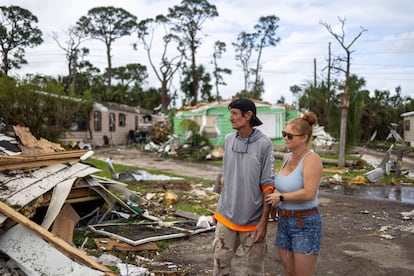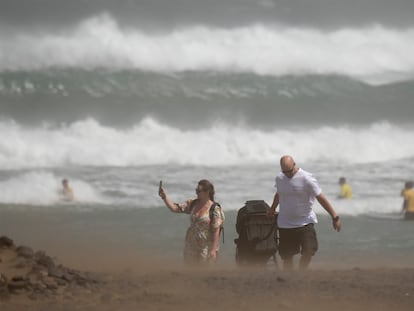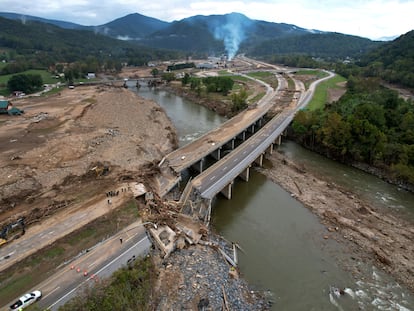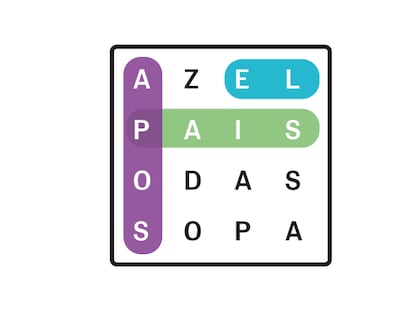In which states will there be more hurricanes and storms this weekend?
Texas recorded the highest number of tornadoes from 2020 to 2024


In recent days, there have been tornadoes in several U.S. states, such as Missouri, Colorado and Kentucky, which left a great path of destruction, as well as dozens of deaths and injuries. These phenomena affected an area known as Tornado Alley, where they tend to be more frequent in the months of May and June. Others were also seen in Mississippi, southeastern Ohio, Alabama, Tennessee and Illinois, causing significant damage to homes.
What’s in the forecast for the weekend?
After a past weekend of storms, millions of people in the Plains and Midwest are now under threat of a new wave of severe weather. The National Weather Service’s Storm Prediction Center (SPC) warns of the possibility of several strong to severe tornadoes in the central and southern Plains states, especially in Kansas and northern Oklahoma. Cities such as Wichita, Salina, Enid and Hutchinson face the greatest risks, with more than 12 million people in the broader threat area, which also includes parts of Texas, Missouri, Arkansas and Nebraska.
Severe weather is expected to affect much of the central and southern United States over Memorial Day weekend, with storms bringing damaging winds, hail, flash flooding and even tornadoes. Although the intensity of the storms may decrease compared to earlier in the week, the risk remains high locally. The storm system responsible for nearly 300 severe weather reports since Monday is forecast to persist, with new rounds of storms developing from Texas to the central Plains, then creeping eastward toward the Gulf Coast and southeastern states by Memorial Day.
Meanwhile, other regions of the country also face weather problems. A late-season squall will hit New England with strong coastal winds, rain and unusually cold temperatures just before the weekend, which could disrupt the celebrations.
The West, on the other hand, will be calm, with sunny skies in Los Angeles and possible showers in the Pacific Northwest. Hurricane season also looms in the Atlantic, with forecasters warning of a very active year due to higher-than-average sea surface temperatures. At the same time, the National Weather Service is facing staffing and resource problems, which may make it difficult to issue timely storm warnings amid the current spate of extreme weather events.
Where are tornadoes seen the most?
According to data compiled by USAFacts, Texas saw the most tornadoes from 2020 to 2024, with more than 100 such events per year. However, no county in the state is in the top spots for tornado activity. Washington County, Colorado, has seen the most, 40 total in four years, which is 13 more than any other county.
Followed by Washington, Cook County in Illinois and Mobile County in Alabama saw the most tornadoes. Illinois had three of its counties in the top five most frequent tornado locations.
Since the 1990s, the economic impact of natural disasters (which include, in addition to tornadoes, other severe storms, cyclones, floods, droughts, and forest fires) has increased, as have deaths. Experts link this to the effects of climate change. Texas is the state with the highest number of reported natural disasters that have caused billions of dollars in damages, mainly in its central, southern and southeastern regions.
Safety
According to figures, in 2024, 23 states reported people with tornado-related injuries, while 15 reported fatalities. Nationwide, 546 people were injured, while 47 lost their lives, mostly in Texas, Oklahoma (where the most injuries were reported, 44% of all) and Florida.
Property Damage
In 2024, NOAA reported $1.6 billion in property damage, of which more than half occurred in Florida ($893 million), followed by Oklahoma (with $264 million). Minnesota was the state with the highest amount of crop damage reported ($545,000).
In 2025
On April 2-6, 2025, a major wave of tornadoes struck parts of the central and eastern United States. It began with a high-risk weather warning in the lower Mississippi Valley and triggered several strong tornadoes. An EF3 tornado struck near Latty, Missouri, followed by another EF3 near Lake City, Arkansas. Later that afternoon, an EF2 tornado killed one person in Delta, Missouri. Severe weather continued through the night of April 3, with four EF3 tornadoes striking cities in Kentucky, Mississippi, and Tennessee, resulting in a total of seven fatalities. Although activity decreased after April 4, several more tornadoes occurred in the South, including an EF2 that killed one person in Stringer, Mississippi, on April 6. In all, 39 significant tornadoes were recorded, four of which caused fatalities.
Just a few weeks later, another devastating outbreak developed on May 15-16, 2025, in the Midwest and Ohio Valley. On May 15, several EF2 tornadoes struck Wisconsin, while weaker ones affected the Great Lakes. The following day saw much more destructive storms: an EF3 tornado killed five people in St. Louis, Missouri, and another EF3 caused two deaths near Blodgett. An EF2 tornado near Linton, Indiana, also killed one person. That night, a powerful EF4 tornado ripped through areas near Marion, Illinois, while another EF4 struck Somerset and London, Kentucky, killing 19 people and causing damage.
An outbreak of tornadoes also occurred between May 18 and 19, where more than 28 tornadoes were seen, resulting in at least 27 deaths.
Tu suscripción se está usando en otro dispositivo
¿Quieres añadir otro usuario a tu suscripción?
Si continúas leyendo en este dispositivo, no se podrá leer en el otro.
FlechaTu suscripción se está usando en otro dispositivo y solo puedes acceder a EL PAÍS desde un dispositivo a la vez.
Si quieres compartir tu cuenta, cambia tu suscripción a la modalidad Premium, así podrás añadir otro usuario. Cada uno accederá con su propia cuenta de email, lo que os permitirá personalizar vuestra experiencia en EL PAÍS.
¿Tienes una suscripción de empresa? Accede aquí para contratar más cuentas.
En el caso de no saber quién está usando tu cuenta, te recomendamos cambiar tu contraseña aquí.
Si decides continuar compartiendo tu cuenta, este mensaje se mostrará en tu dispositivo y en el de la otra persona que está usando tu cuenta de forma indefinida, afectando a tu experiencia de lectura. Puedes consultar aquí los términos y condiciones de la suscripción digital.
More information
Archived In
Últimas noticias
From Andorra to Gibraltar, a black market for Ozempic exploits its success: ‘They’re the most sought-after products in the world’
From Hungary’s Orbán to Chile’s Kast: How Trump helps turbo charge the far right
Magnets in their heads: How some animals guide themselves using the Earth’s magnetic field
The brief rise and retreat of Generation Z in Mexico
Most viewed
- Why we lost the habit of sleeping in two segments and how that changed our sense of time
- Trump’s obsession with putting his name on everything is unprecedented in the United States
- Charles Dubouloz, mountaineering star, retires at 36 with a farewell tour inspired by Walter Bonatti
- Venezuela faces its most tense Christmas yet
- The Florida Keys tourist paradise is besieged by immigration agents: ‘We’ve never seen anything like this’










































